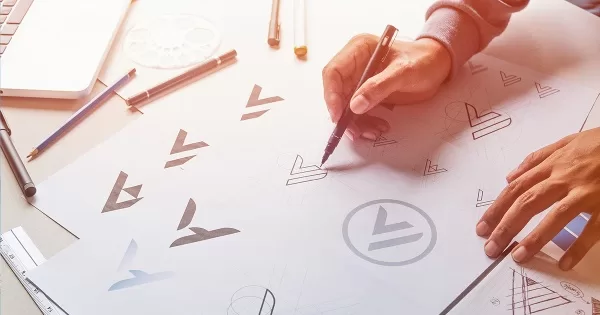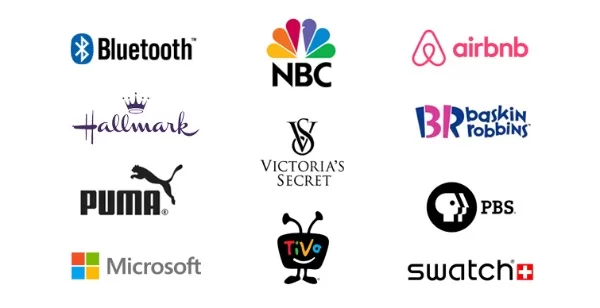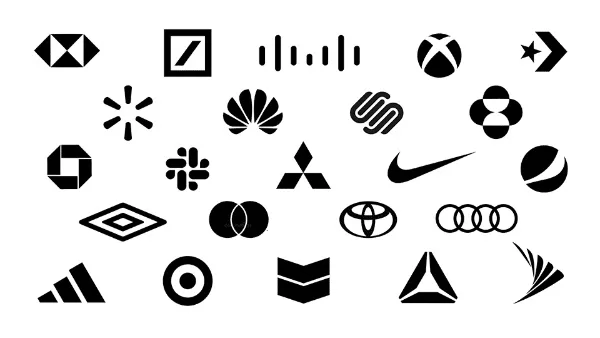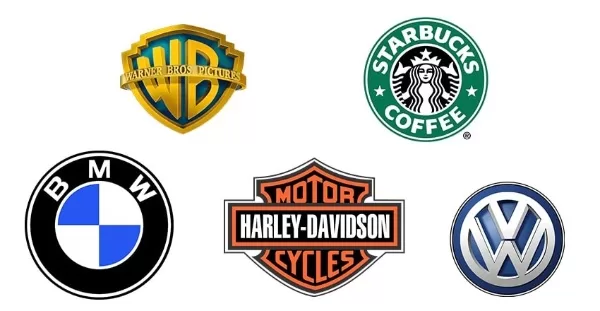Insights
The 7 Essential Types of Logo Design: Which Style is Right for Your Brand?
On Digitals
19/11/2025
48
When you think about the world’s most recognizable brands, what comes to mind first? Chances are, it’s their logo. That simple visual mark that appears on everything from business cards to billboards. But here’s the thing: not all logos are created equal, and understanding the different types of logo can make or break your brand’s first impression.
Why Should I Learn About the Different Types of Logo?
Think of your logo as your brand’s handshake. It’s often the first point of contact between you and potential customers, and we all know how important first impressions are. But there’s more to it than just looking professional.
The types of logo design you choose influences how people perceive your brand from the get-go. A playful mascot logo tells a completely different story than a sophisticated emblem, right? This visual shorthand helps customers instantly understand what your brand is about before they even read a single word.
But here’s where it gets practical. The style you choose dictates how versatile your logo will be. Will it look good on a tiny mobile app icon? Can you embroider it on a t-shirt? Does it scale up nicely for a massive trade show banner? Some logo types handle these challenges better than others.

Why should you choose the perfect logo type?
The 7 Core Types of Logo Design Explained
Let’s break down the main types of logo that businesses use today. Each has its own strengths, and understanding them will help you figure out which one fits your brand best.
1. Lettermarks (Monograms)
Lettermarks are typography-based logos made up of just a few letters, usually a company’s initials. Think IBM, NASA, CNN, or HBO. These brands have names that are either long or made up of multiple words, so they’ve simplified things by using just their initials.
When to Use It: If your business name is a mouthful, a lettermark can be your best friend. It’s way easier for people to remember “HP” than “Hewlett-Packard.” The simplified approach makes your brand more approachable and easier to recall.
Key Consideration: Since typography is literally the entire design, your font choice carries all the weight here. The typeface you select needs to convey your brand’s personality perfectly. Are you traditional and trustworthy? Go with something like a serif font. Modern and clean? A sans-serif works better. And again, make sure it’s legible when printed small on business cards or scaled down for digital use.

Lettermark and wordmark logos can be a great choice
2. Wordmarks (Logotypes)
Similar to lettermarks, wordmarks are font-based logos, but instead of using initials, they feature the full brand name. Google, Visa, and Coca-Cola are classic examples of wordmark logos done right.
When to Use It: Wordmarks work brilliantly when your company has a short, distinct, or catchy name. If your business name itself is memorable, why hide it? This style helps drill your name into customers’ minds through repetition and visual consistency.
Key Consideration: The beauty of wordmarks is that they rarely go out of style when done properly. However, your custom font choice is absolutely critical. It needs to be unique enough to stand out from competitors while remaining timeless. Fashion brands often use elegant, clean fonts that scream luxury, while tech companies might opt for modern, geometric typefaces that feel cutting-edge.
3. Pictorial Marks (Brand Marks or Icons)
Now we’re getting into image territory. Pictorial marks are recognizable icons or symbols that represent your brand. Apple’s bitten apple and Twitter’s bird (before it became X) are perfect examples of pictorial marks that became so iconic, they don’t even need the company name attached anymore.
When to Use It: Here’s the catch with pictorial marks: they require some existing brand recognition to stand alone effectively. For new companies, it’s risky to go icon-only because people won’t immediately know who you are. However, if you already have a following or if your icon conveys immediate meaning or emotion (like a lightning bolt for speed), it can work beautifully, though not without something unique to distinguish your brand if it’s new.
Key Consideration: If you’re a new company, you should generally pair your pictorial mark with text first (more on combination marks later). Use them together until your symbol becomes iconic enough to fly solo. Think about the broader implications of the image you choose. Does it play on your name? Does it create deeper meaning? Will it still make sense if your business evolves?

The more abstract options are reserved for those with a stable position
4. Abstract Marks
Abstract marks are a special type of pictorial logo that use geometric shapes or forms to represent a conceptual idea rather than a recognizable object. Nike’s Swoosh, Adidas’s three stripes, and BP’s starburst are all abstract marks that have become deeply associated with their brands.
When to Use It: Abstract marks give you the freedom to create something completely unique that’s tied directly to your brand values without being limited by recognizable imagery. They’re excellent for global brands and multinational corporations that need a symbol that transcends language barriers. After all, a stylized shape means the same thing in Vietnam as it does in Venezuela.
The Nike Swoosh is a masterclass in this approach. It doesn’t look like anything specific, but it conveys movement, speed, and dynamism perfectly. That’s the power of abstraction done right.
Key Consideration: Creating an effective abstract mark requires serious design skills. Color and form need to work together to attribute meaning and cultivate emotion around your brand. It’s definitely worth investing in professional design help for this logo type.
5. Mascots
Mascot logos feature illustrated characters, often cartoonish and friendly, that act as your brand’s “spokesperson.” KFC’s Colonel Sanders, the Michelin Man, and Mr. Peanut are all mascots that have become inseparable from their brands.
When to Use It: Mascots are perfect for brands targeting families or children, or for any company seeking a playful, approachable personality. They’re fantastic for building warm, enduring relationships with customers because people naturally connect with characters more easily than with abstract symbols or text.
Sports teams love mascots for a reason. They create a fun, interactive element that can be used at events, on social media, and in marketing campaigns. There’s something inherently engaging about a character that can “interact” with your audience.
Key Consideration: While mascots are fun and memorable, they can be tricky to scale down. A highly detailed character might look great on a poster but become a blurry mess on a business card. You’ll likely need to create simplified versions for different applications.

Emblems are also a good shout but only with decent structure
6. Emblems
Emblems are logos where the brand name and symbol are inseparable, typically contained within a border or crest. Think Starbucks, Harley-Davidson, or university logos. They have a distinctly classic, established feel.
When to Use It: Emblems convey tradition, authority, and heritage like no other logo type. They’re highly effective for organizations, government bodies, educational institutions, or brands that want to inspire exclusivity and prestige. The auto industry loves emblems because they communicate quality and legacy.
Key Consideration: The intricate details that make emblems look impressive can also be their downfall. They’re less scalable and harder to reproduce on small items like promotional pens or as tiny website favicons. If you’re considering an emblem, keep the design as clean as possible while maintaining that classic look you’re after.
7. Combination Marks (The Versatile Option)
Combination marks do exactly what the name suggests: they combine a wordmark or lettermark with a pictorial or abstract mark. Lacoste’s crocodile next to the word “Lacoste,” Doritos, and Burger King are all combination marks.
When to Use It: This is the most versatile and popular logo type, especially for new companies. It lets you build image recognition while clearly stating your name. As your brand becomes established, you gain the flexibility to use either the icon or text separately. Lacoste does this perfectly, using just the crocodile on their shirts while using the full combination mark on their website and marketing materials.
Key Consideration: Combination marks offer the best of both worlds. They ensure high recall value and adaptability across all media. You can stack the elements vertically, place them side by side, or even integrate them in creative ways. This flexibility is why so many successful brands choose this route.
How Do I Choose the Right Logo Type Online for My Vietnamese Business? (A Practical Guide)
Alright, so you understand the different types of logo now. But how do you actually decide which one is right for your business? Let’s break it down into practical steps.
Assess Your Brand’s Key Attributes
Start by looking at your brand honestly. Here are some questions to ask yourself:
Brand Name Length: Is your name long and complicated? Consider a lettermark to simplify it. Got a short, punchy name? A wordmark could work beautifully. This is basic, but it matters more than you think.
Target Audience and Personality: Who are you trying to reach? A playful, youthful audience might respond better to mascots or combination marks with fun elements. An established, serious B2B brand? Emblems or clean wordmarks signal professionalism and reliability.
Global Ambition: Planning to expand internationally? Abstract marks and pictorial marks are strong choices because they work across language barriers. A symbol doesn’t need translation, but a wordmark might get lost when your Vietnamese name doesn’t mean anything to someone in Germany.
Mastering the Two Critical Design Elements
Once you’ve narrowed down your logo type, you need to nail two crucial elements:
Typography: Fonts have psychological effects that go way beyond just looking nice. Serif fonts (the ones with little feet on the letters) feel traditional and serious. Think law firms and financial institutions. Sans-serif fonts are modern and clean, perfect for tech companies and contemporary brands. Script fonts convey elegance and personalization, but use them carefully because they can be hard to read when scaled down.
Color Psychology: Colors aren’t just decoration. They trigger emotional responses. Green suggests sustainability and growth (perfect for eco-friendly brands). Blue communicates trust and security (banks and insurance companies love blue). Red is energetic and urgent (food brands and sale signs). Yellow is optimistic and youthful.
Choose a color palette that matches your brand’s message and stick with it consistently across all touchpoints.
The Non-Negotiable Rules for Versatility and Longevity
Regardless of which logo type you choose, these principles apply universally:
Simplicity and Memorability: The goal is instant recognition. Think about the Nike Swoosh again. It’s so simple a child could draw it, yet it’s one of the most valuable logos in the world. Avoid excessive detail and trendy effects that will look dated in a couple of years. What feels cutting-edge today might look embarrassingly outdated tomorrow.
Scalability Check: Your logo needs to look clear and professional whether it’s tiny on a mobile app icon or massive on a billboard. Here’s a practical test: print your logo at the size of a postage stamp. Can you still clearly make out all the elements? If not, it needs simplification. Also, ensure it looks good in both full color and monochrome (black and white), because you’ll inevitably need to use it in situations where color isn’t available.
Ready to see the right logo style for your industry? Explore successful case studies and real-world examples of different types of logo design in action to get inspired for your own brand.

All elements to note to put together the perfect logo for your business
Logo Design Essentials: Preparing Your Files for Print and Digital Use
So you’ve designed your perfect logo. Now what? Getting the technical details right is just as important as the design itself, especially if you want your logo to look professional everywhere it appears.
Why Vector Files (SVG/PDF/EPS) are Essential
This is where things get a bit technical, but stick with me because it’s important. Vector files use mathematical formulas to create images, which means they can be infinitely resized without losing quality. Blow them up to billboard size or shrink them down to a business card, and they’ll stay perfectly crisp.
This is non-negotiable for print work and large-scale use. If you try to print a small JPG file on a large banner, you’ll end up with a pixelated, blurry mess that makes your brand look unprofessional.
Contrast this with raster files (JPG/PNG): These are made up of pixels, so they have fixed dimensions. They’re suitable for specific digital applications like social media profile pictures or website graphics, but they don’t scale well. You need both types of files, but your master logo file should always be vector.
Understanding the Logo Variations You Need
Professional brands don’t just have one logo file. They have a whole family of variations to suit different needs:
Full-color version (Primary): This is your main logo with all your brand colors. Use it whenever possible on white or light backgrounds.
Single-color versions (Black and White): You need clean black versions for when you’re printing on colored paper or need high contrast. White versions are crucial for dark backgrounds. These monochrome versions prove your logo works even without color.
Transparent background versions: These are absolutely crucial for digital overlays. You need PNG files with transparent backgrounds so you can place your logo over photos, colored backgrounds, or different website designs without that awkward white box around it.
Having all these variations ready means you’re prepared for any situation, from embroidered uniforms to website headers to printed invoices.
FAQ: Quick Answers to Common Logo Type Queries
What is the most versatile logo type?
The combination mark takes the crown for versatility. It provides both the brand name and a visual icon, allowing it to be adapted across nearly every medium successfully. You get the recognition benefits of text-based logos plus the visual impact of symbolic logos. As your brand grows, you can even separate the elements and use them independently once you’ve built sufficient recognition.
Should a new business use a pictorial mark?
Generally, it’s better to start with a combination mark (text plus icon). An icon alone is harder for a new company to establish because people don’t yet associate the symbol with your brand name. You need to build that connection first. Once you’re as famous as Apple or Nike, then you can ditch the text and let your icon fly solo. But for now, help people remember you by including your name.
What is the difference between logotype and logomark?
A logotype (also called a wordmark) is text-only, featuring just your brand name in a stylized font. Think Coca-Cola or Google. A logomark (also called a pictorial mark) is an image or symbol only, with no text. The Twitter bird or the Apple apple are logomarks. When you combine both, that’s a combination mark. Knowing these terms helps you communicate more clearly with designers and makes the whole process smoother.
Final Thoughts: What Types of Logo Can Your Business Go For?
Understanding the different types of logo is essential for building a brand that resonates with your audience and stands the test of time. The types of logo design all serve a specific purpose and tell a different story. The key is selecting a logo type that aligns with your brand values, works across all platforms, and creates lasting recognition in your customers’ minds.
Already have some ideas running through your mind? On Digitals is ready to make that a reality with our logo design services. Thanks to our considerable experiences in assisting businesses with their branding strategies, we can learn more about your business goals and reflect that in our logo designs.
NEWEST POSTS
- Nano Vs micro influencers: Key differences And Best Uses
- Google Core Web Vitals Optimization & Page Speed
- Micro Influencer Marketing For Better Reach And Stronger Engagement
- How to Build Topical Authority SEO for Stronger Rankings and Trust Online
- AI Overviews SEO – Guide To Its Impacts On Search Visibility!
Read more
